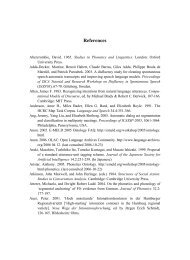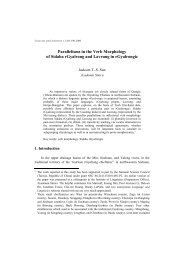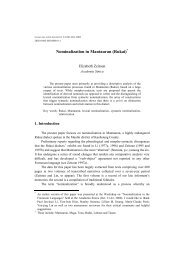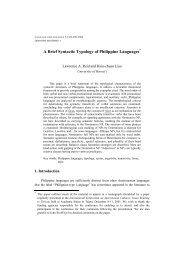Loanwords from English to Malay in the Field of Mathematics*
Loanwords from English to Malay in the Field of Mathematics*
Loanwords from English to Malay in the Field of Mathematics*
Create successful ePaper yourself
Turn your PDF publications into a flip-book with our unique Google optimized e-Paper software.
<strong>Loanwords</strong> <strong>from</strong> <strong>English</strong> <strong>to</strong> <strong>Malay</strong> <strong>in</strong> <strong>the</strong> <strong>Field</strong> <strong>of</strong> Ma<strong>the</strong>matics<br />
For each <strong>of</strong> <strong>the</strong>se terms, <strong>the</strong> correspond<strong>in</strong>g term <strong>in</strong> <strong>the</strong> <strong>Malay</strong> language was found<br />
by consult<strong>in</strong>g <strong>English</strong>-<strong>Malay</strong> technical dictionaries (DBP 1992, Nik Ahmad et al.<br />
1991). The terms not found <strong>in</strong> ei<strong>the</strong>r dictionary were translated <strong>in</strong><strong>to</strong> <strong>Malay</strong> via<br />
consultation with <strong>Malay</strong>-speak<strong>in</strong>g ma<strong>the</strong>maticians.<br />
The <strong>Malay</strong> language terms were <strong>the</strong>n compared with <strong>the</strong> <strong>English</strong> language terms,<br />
and classified accord<strong>in</strong>g <strong>to</strong> <strong>the</strong> type <strong>of</strong> loanword. There were two broad classes, <strong>the</strong><br />
s<strong>in</strong>gle-word loanwords (81 terms), and <strong>the</strong> compound loanwords (119 terms). With <strong>the</strong><br />
first class, <strong>the</strong> ‘types’ <strong>of</strong> loanwords were non-loanwords, nuclear loanblends, marg<strong>in</strong>al<br />
loanblends, orthographically assimilated loanwords, truncated loanwords, wholly<br />
assimilated loanwords, partially assimilated loanwords, unassimilated loanwords and<br />
semantic extensions. Amongst <strong>the</strong> compound loanwords <strong>the</strong>re were <strong>the</strong> fused<br />
compounds, <strong>the</strong> nuclear compound loanblends, <strong>the</strong> marg<strong>in</strong>al compound loanblends, <strong>the</strong><br />
analysed compound loanblends, literal loan translations and syntactic substitutions.<br />
This classification is modeled closely after that <strong>of</strong> (Heah 1989), <strong>to</strong> which <strong>the</strong> reader is<br />
referred for def<strong>in</strong>itions. A list <strong>of</strong> <strong>the</strong> ma<strong>the</strong>matical terms, with <strong>the</strong>ir translations and<br />
<strong>the</strong>ir classification <strong>in</strong><strong>to</strong> <strong>the</strong>se types, may be found <strong>in</strong> <strong>the</strong> Appendix.<br />
The two classes (s<strong>in</strong>gle-term loanwords and compound loanwords) were analysed<br />
separately. The reason for analys<strong>in</strong>g each class separately was that if <strong>the</strong> classes were<br />
analysed <strong>to</strong>ge<strong>the</strong>r, a tendency for one book <strong>to</strong> lean <strong>to</strong>wards certa<strong>in</strong> loanword types<br />
might reflect a tendency <strong>of</strong> <strong>the</strong> author <strong>of</strong> <strong>the</strong> book <strong>to</strong> be verbose or succ<strong>in</strong>ct <strong>in</strong> his or her<br />
<strong>in</strong>dex, ra<strong>the</strong>r than any real tendency <strong>in</strong> <strong>the</strong> ma<strong>the</strong>matical language. In each class, a<br />
cont<strong>in</strong>gency table was set up stat<strong>in</strong>g <strong>the</strong> number <strong>of</strong> loanwords <strong>of</strong> each type <strong>in</strong> each<br />
book. The <strong>in</strong>tention was <strong>to</strong> analyse <strong>the</strong> data us<strong>in</strong>g a chi-squared test <strong>to</strong> determ<strong>in</strong>e if<br />
<strong>the</strong>re is any difference between <strong>the</strong> books <strong>in</strong> terms <strong>of</strong> <strong>the</strong>ir tendencies <strong>to</strong>wards various<br />
loanword types. To this end, some <strong>of</strong> <strong>the</strong> ‘type’ categories needed <strong>to</strong> be merged, s<strong>in</strong>ce<br />
<strong>the</strong>re were <strong>to</strong>o few words <strong>in</strong> <strong>the</strong> <strong>in</strong>dividual categories <strong>to</strong> draw mean<strong>in</strong>gful conclusions<br />
<strong>from</strong> <strong>the</strong> statistical test.<br />
The categories so merged were as follows: Amongst <strong>the</strong> s<strong>in</strong>gle-word loanwords,<br />
<strong>the</strong> ‘non-loanwords’ category was merged with <strong>the</strong> ‘semantic extensions’ category, <strong>the</strong><br />
‘orthographically assimilated loanwords’ were left as a category by <strong>the</strong>mselves, and <strong>the</strong><br />
o<strong>the</strong>r s<strong>in</strong>gle-word loanword categories were all merged <strong>to</strong>ge<strong>the</strong>r <strong>to</strong> form a s<strong>in</strong>gle group<br />
called ‘o<strong>the</strong>rs’. Amongst <strong>the</strong> compound loanwords, <strong>the</strong> ‘literal loan translations’<br />
category was merged with <strong>the</strong> ‘syntactic substitutions’ category, ‘nuclear compound<br />
loanblends’ with <strong>the</strong> ‘marg<strong>in</strong>al compound loanblends’, and <strong>the</strong> ‘analysed compound<br />
loanblends’ was left <strong>in</strong> a category by itself. Out <strong>of</strong> <strong>the</strong> 200 terms, only one was<br />
classified as a fused compound, namely self-adjo<strong>in</strong>t (<strong>from</strong> Analysis), which <strong>in</strong> <strong>Malay</strong><br />
becomes swadamp<strong>in</strong>gan. S<strong>in</strong>ce this category could not be sensibly merged with any <strong>of</strong><br />
<strong>the</strong> o<strong>the</strong>rs, and s<strong>in</strong>ce no statistically significant conclusion whatsoever can be drawn<br />
<strong>from</strong> a s<strong>in</strong>gle datum <strong>in</strong> a category by itself, it was decided reluctantly <strong>to</strong> omit this item<br />
<strong>from</strong> <strong>the</strong> analysis. The f<strong>in</strong>al categories and data may be seen <strong>in</strong> Tables 1 and 2, below.<br />
65










